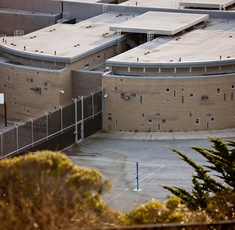“It’s pretty clear that young people are not getting their hour a day outdoors,” said commission director Mario Yedidia after reviewing the survey results. “The culture of the institution seems like it’s not really encouraging of outdoor exercise.
Despite the survey’s findings, Chief of Juvenile Probation William Siffermann has insisted for months that the hall is in compliance with all state regulations. “Some kids don’t want to go outside,” he said at one point, “and I can’t force them out there.”
All but one of the detainees surveyed said they liked visiting the indoor gym, but almost half said they used it fewer than four days a week. Basketball was the most popular activity, and several kids used their questionnaires to request that hoops be installed on the small concrete courtyards adjacent to their units.
“We need a basketball hoop, please,” wrote one detainee.
Another complained: “We only play basketball. We need more sports.”
The Youth Commission, a panel of 17 San Franciscans ages 12 to 23 appointed by the mayor, makes policy recommendations to city leaders and began pushing for more outdoor recreation at the hall last year.
In February, the commission drafted a resolution calling for detainees to have regular access to a large outdoor space at the hall that had sat unused since it was built in 2006 as part of a $47 million renovation. Siffermann said then that security concerns and staff shortages prevented safe usage of most areas of the large yard.
Subsequent inquiries by the commission raised questions about the hall’s compliance with state regulations. Although a 2010 state inspection found no compliance issues at the facility, the commission and Board of Supervisors asked Siffermann to provide documentation showing how often individual detainees go outside.
Until now, staff at the hall has not recorded that information, but Siffermann told The Bay Citizen this week that he will begin reporting those numbers to the Youth Commission on a quarterly basis.
Youth commissioners said that the lack of interest in outdoor recreation indicated in the new survey results took them by surprise.
“The results were not what we were expecting, but they speak to the gravity of the situation,” said Paul Monge-Rodriguez, a 23-year-old youth commissioner. “Kids at this age should want nothing more than to go outside and engage with their peers.”
The results demonstrated the hall’s need for more recreational programs, he added.
“There’s a limited number of recreational activities to fulfill the state’s large-muscle exercise requirements,” he said. “The survey shows there’s a lot of basketball, but it’s like being offered the same one meal every day, and people get sick of the lack of variety and lose interest.”
Angel Carrion, who was locked up for two years at the hall before joining the Youth Commission, said the lack of outdoor activity shows that the institutional setting has taken a mental toll on youth in the hall.
All but one of the detainees surveyed said they liked visiting the indoor gym, but almost half said they used it fewer than four days a week. Basketball was the most popular activity, and several kids used their questionnaires to request that hoops be installed on the small concrete courtyards adjacent to their units.
“We need a basketball hoop, please,” wrote one detainee.
Another complained: “We only play basketball. We need more sports.”
The Youth Commission, a panel of 17 San Franciscans ages 12 to 23 appointed by the mayor, makes policy recommendations to city leaders and began pushing for more outdoor recreation at the hall last year.
In February, the commission drafted a resolution calling for detainees to have regular access to a large outdoor space at the hall that had sat unused since it was built in 2006 as part of a $47 million renovation. Siffermann said then that security concerns and staff shortages prevented safe usage of most areas of the large yard.
Subsequent inquiries by the commission raised questions about the hall’s compliance with state regulations. Although a 2010 state inspection found no compliance issues at the facility, the commission and Board of Supervisors asked Siffermann to provide documentation showing how often individual detainees go outside.
Until now, staff at the hall has not recorded that information, but Siffermann told The Bay Citizen this week that he will begin reporting those numbers to the Youth Commission on a quarterly basis.
Youth commissioners said that the lack of interest in outdoor recreation indicated in the new survey results took them by surprise.
“The results were not what we were expecting, but they speak to the gravity of the situation,” said Paul Monge-Rodriguez, a 23-year-old youth commissioner. “Kids at this age should want nothing more than to go outside and engage with their peers.”
The results demonstrated the hall’s need for more recreational programs, he added.
“There’s a limited number of recreational activities to fulfill the state’s large-muscle exercise requirements,” he said. “The survey shows there’s a lot of basketball, but it’s like being offered the same one meal every day, and people get sick of the lack of variety and lose interest.”
Angel Carrion, who was locked up for two years at the hall before joining the Youth Commission, said the lack of outdoor activity shows that the institutional setting has taken a mental toll on youth in the hall.

